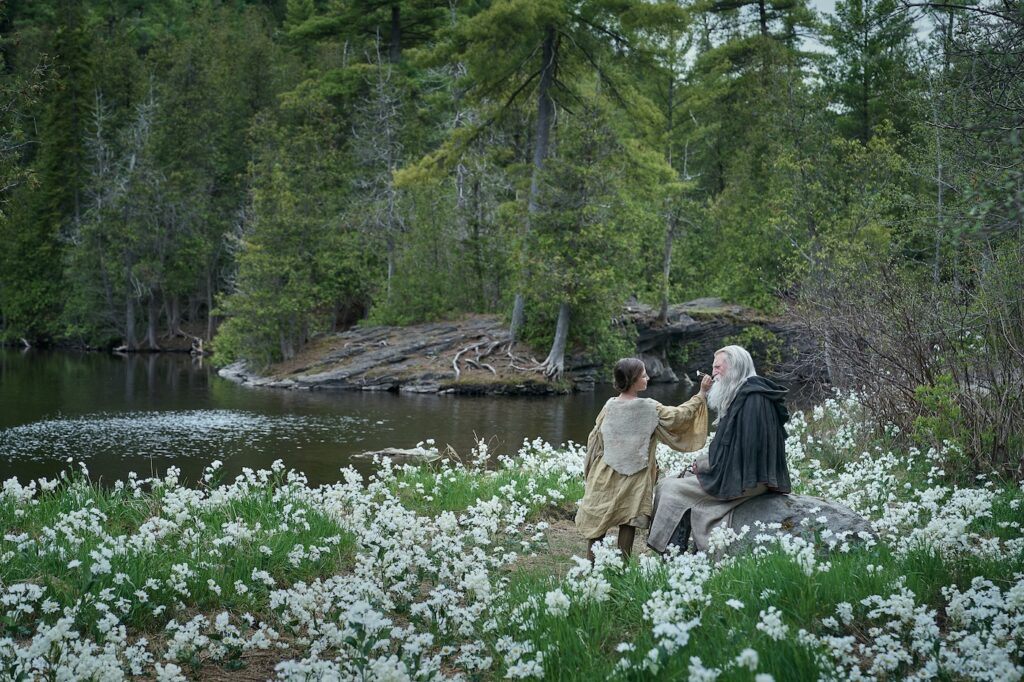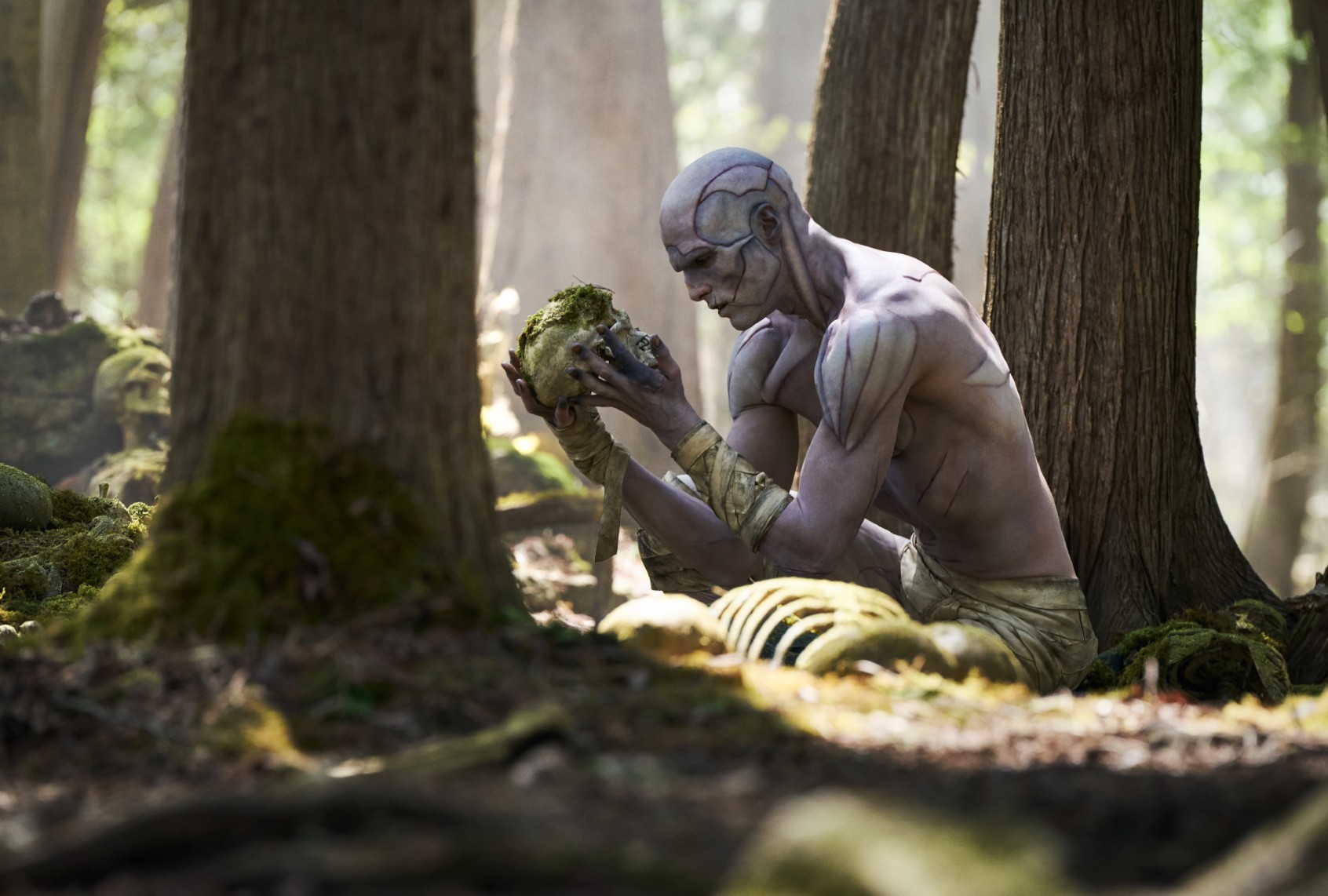Before he learns speech, before he learns cruelty, before he learns the terrible weight of a creator’s indifference, The Creature in “Frankenstein” learns hunger. And then — astonishingly — he learns generosity. Guillermo del Toro renders this with a small sunlit vision: a hulking figure perched on a rooftop, savoring a loaf left out for the spirit the villagers imagine him to be. It’s a fleeting tableau, but it reveals the whole story: even the most forsaken creation reaches for connection the moment he’s given something warm to hold in his hands.
I kept turning that scene over in my mind after I watched the film.
Del Toro’s “Frankenstein” isn’t a food movie by any stretch, but the moments that lodged themselves in my memory all involved nourishment — offered, stolen, shared, withheld. Food becomes a visual shorthand for connection, a way of grounding an immortal creature to the earth and to the fragile, frightened humans who move through it. In a story built on hubris, violence and scientific ambition, it’s the smallest gestures of sustenance that feel the most human.
The film follows Mary Shelley’s original contours: The Creature (Jacob Elordi) is abandoned by Victor Frankenstein (Oscar Isaac), left chained in a burning castle as an unwanted experiment gone wrong. His escape deposits him into a frozen wilderness, where the first humans he encounters react to him with instinctive horror. A hunting party shoots him — the first hint that this version of The Creature is not merely hard to kill but possibly incapable of dying at all. Gunshots, dynamite, fire: none of it seems to leave a lasting mark. And yet he’s fascinated by the people who just tried to destroy him, drawn to them, eventually peering through their window at a life he wasn’t invited to join.
He follows them to a modest hut on the edge of the forest, a household held together by love and scarcity: a blind old man, a few children, a flock of sheep and the kind of persistent winter poverty that makes every scrap of food feel hard-earned. From the shadows, he watches them, wanting something he doesn’t yet have a name for. And when that longing becomes too acute, he starts to help them — gathering their firewood, repairing their fences, performing small miracles of labor under cover of night. The family assumes these blessings are the work of a benevolent forest spirit. Only we know it’s a creature who has never been shown kindness offering it anyway.
“And on occasion, they too extended a small kindness towards me,” The Creature says in the film. “Clothes, bread.”
We need your help to stay independent
This is when del Toro shows him perched on their rooftop, legs splayed, face tipped toward the sun as he bites into one of those loaves.“And for a moment — a brief, brief moment — the world and I were at peace.” The film rarely grants him this kind of serenity, and that’s why the scene hits so hard: the first thing to make him feel human is something as humble as bread in the sun.
Shelley’s novel sketches this arc with even more texture. The Creature’s earliest meals are desperate and primitive — acorns plucked straight from the tree (which would wreck a human stomach), fistfuls of berries, icy water scooped from a stream. He learns to tend fire and realizes that it is not only good for heat, but for making food palatable. When he stumbles upon the hut of a shepherd who flees at the sight of him, he “greedily devoured the remnants of the shepherd’s breakfast, which consisted of bread, cheese, milk and wine.”
After days of chewing raw nuts and fruit, the meal must have tasted miraculous, but the richest development happens when he encounters the De Lacey family. Hidden among the trees, he studies them for weeks, stealing bits of their food when he can manage it. Slowly, painfully, he realizes they are miserable not because of one another but because they are poor, a hardship he has been quietly worsening by pilfering their stores. It’s his first pang of guilt, the first time he understands that his needs are not the only ones that matter. And so he resolves to repay them in the only way he knows: with labor, with devotion, with the silent caretaking that eventually convinces them they’re being aided by a benevolent forest spirit.
Which brings us back to the mythology of the film — this idea of The Creature as an unseen guardian, a half-believed blessing.
Want more great food writing and recipes? Sign up for Salon’s free food newsletter, The Bite.
Soon, the younger family members take a seasonal trip, leaving The Blind Man (De Lacey, in the novel; played with heartbreaking gentleness by David Bradley in the film) alone for part of the winter. The Creature lingers, too, hovering at the edges of the hut and eventually, the solitude becomes unbearable — his longing too loud to ignore — and he tries to introduce himself, despite his vocabulary still being mostly a single trembling word: “Victor.”
And again, del Toro reaches for food as the bridge.
“My sight has failed me,” the old man says, turning toward the presence he can sense but not see. “But there is bread and brandy on the table. Pray help yourself.” It’s such a humble invitation, almost an afterthought, and yet it’s the first time anyone in the story has offered The Creature anything without fear or revulsion. In the film, the moment lands with a warmth that’s almost painful: kindness given freely, even blindly, becomes the thing that finally draws The Creature out of hiding.

(Ken Woroner/Netflix) (L to R) Sofia Galasso as Anna-Maria and David Bradley as Blind Man in Frankenstein.
Then, when The Blind Man realizes that the rumored “Spirit of the Forest” is, in fact, this wounded, wordless being seeking nothing more than company, his reaction is not terror but tenderness. “Stay with me,” he says. “Share my food and my fire. I would be delighted to share what little I have with you.”
For a heartbeat, you can almost imagine an alternate ending: two lonely figures passing the winter in gentle domesticity, breaking bread, tending the fire, building a language out of generosity. But this is “Frankenstein,” after all. The gothic machinery grinds back into motion. Circumstances spiral, cruelty reasserts itself and The Creature learns — again — that humans will never see him as anything but monstrous, no matter how faithfully he tries to mirror their kindness.
So he begins to dream of another life entirely: a companion shaped like him, someone who might share his baffling immortality, his hunger, his hope. In the book, as in the film, he approaches Victor with a proposal:
“If you consent, neither you nor any other human being shall ever see us again; I will go to the vast wilds of South America. My food is not that of man; I do not destroy the lamb and the kid to glut my appetite; acorns and berries afford me sufficient nourishment. My companion will be of the same nature as myself and will be content with the same fare. We shall make our bed of dried leaves; the sun will shine on us as on man and will ripen our food. The picture I present to you is peaceful and human, and you must feel that you could deny it only in the wantonness of power and cruelty.”
It’s a vision that feels almost Edenic: two creations living in sunlit obscurity, eating fruit from the trees, sleeping on beds of leaves, wanting nothing more than to be left alone. It’s a future built entirely on gentleness — the very quality the world has denied him at every turn.
But the tragedy of Frankenstein is that Victor cannot imagine his creation as anything other than monstrous. He destroys the possibility of that peaceful garden before it can be planted. And so the story returns, as it always does, to devastation: a creature who longed to break bread with humanity instead learns to starve himself of hope.
What lingers, though — in both del Toro’s film and Shelley’s original — are the small, luminous moments where food becomes something more than sustenance. A loaf left on a rooftop. Bread and brandy on a table. A shepherd’s breakfast devoured in gratitude. These are the crumbs that map The Creature’s only path toward humanity, however briefly he’s allowed to walk it.
And maybe that’s why those scenes stay with us long after the torches and pitchforks fade: they remind us that even in the darkest stories, connection is made the same way it is in the real world, one shared bite at a time.


